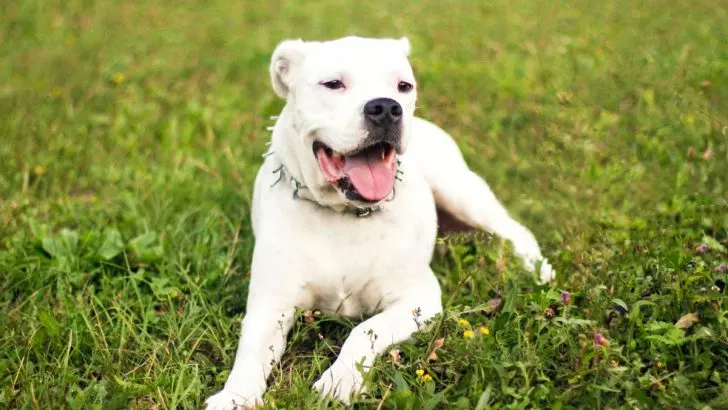Before we dive deep into the Dogo Argentino growth chart and how big Dogo Argentinos get, let me offer you a quick Dogo Argentino summary.
This powerful, athletic, snowy white breed was developed for large game hunting in Argentina. Known for being fierce and protective, the Dogo Argentino is a great security dog and a sweetheart to family members.
These dogs are strong-willed but still affectionate. They will get along well with children and even other pets only if a lot of socialization has been done.
And let me tell you, this article has it all: weight chart, height chart, possible health and growth problems, all the development stages, and some of the most adorable pictures of dogo Argentino pups!
Your puppy can’t be a baby forever, so it’s imperative as your puppy grows to monitor its development to see if it’s hitting all the suitable targets.
From your puppy’s first playful pounces until it stands regal and taller, every growth stage is a remarkable journey of excitement and wonder.
But how do you know if your pup’s on the right track? That’s where our complete guide comes in handy!
Male And Female Dogo Argentino Growth Chart
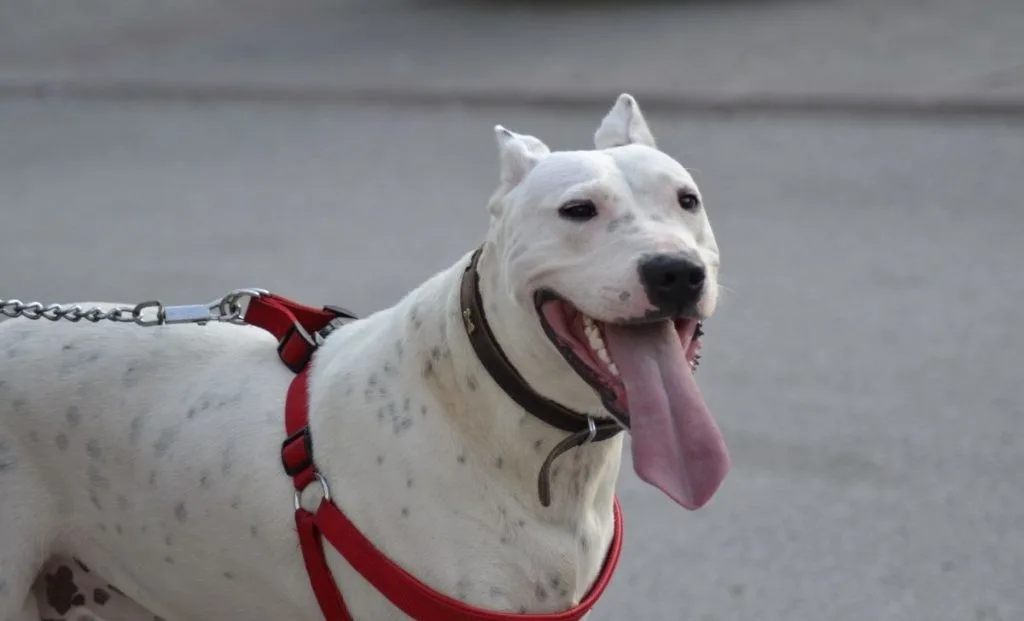
There are observable differences between the growth patterns of male and female Dogo Argentinos, usually expressed in size and weight differences.
Following the breed standard the American Kennel Club (AKC) set, males are usually larger and heavier than females and have a more robust structure.
In general, the males range between 26 to 28 inches (65 to 70 cm) at the withers by 12 months, compared to the females, who usually reach 22 to 26 inches (55 to 65 cm) at the same age.
On average, a male’s weight is between 88 and 99 lbs (40 and 45 kg) by the first year, while the female weight is usually slightly less, between 77 and 88 lbs (35 and 40 kg).
Females of the breed usually mature faster, while the larger males might take up to three years to reach their full height and weight.
The Male Dogo Argentino Growth Chart
The following chart includes the standard weights and heights of a male Dogo Argentino from newborn to 2 years of age.
Please remember that these are only averages. Always consult your vet if you worry about the development of the particular dog in front of you.
| Age | Weight (kg) | Weight (lbs) | Height (cm) | Height (in) |
|---|---|---|---|---|
| Newborn | 0.9 – 2.3 | 2 – 5 | 12 – 15 | 5 – 6 |
| 2 Weeks | 1.8 – 4.5 | 4 – 10 | 15 – 20 | 6 – 8 |
| 1 Month | 4.5 – 6.8 | 10 – 15 | 20 – 25 | 8 – 10 |
| 2 Months | 6.8 – 9.1 | 15 – 20 | 25 – 30 | 10 – 12 |
| 3 Months | 10 – 14 | 22 – 31 | 30 – 35 | 14 – 16 |
| 4 Months | 14 – 18 | 31 – 40 | 35 – 40 | 16 – 18 |
| 5 Months | 18 – 23 | 40 – 51 | 40 – 50 | 18 – 20 |
| 6 Months | 23 – 28 | 51 – 62 | 50 – 55 | 20 – 22 |
| 7 Months | 28 – 32 | 62 – 71 | 55 – 60 | 22 – 24 |
| 8 Months | 32 – 36 | 71 – 79 | 60 – 65 | 24 – 26 |
| 9 Months | 36 – 40 | 79 – 88 | 60 – 65 | 24 – 26 |
| 10 Months | 38 – 42 | 84 – 93 | 60 – 65 | 24 – 26 |
| 11 Months | 40 – 45 | 88 – 99 | 65 – 70 | 26 – 28 |
| 1 year | 45 – 50 | 99 – 110 | 65 – 70 | 26 – 28 |
| 1.5 Years | 50 – 55 | 110 – 121 | 65 – 70 | 26 – 28 |
| 2 Years | 50 – 60 | 110 – 132 | 65 – 70 | 26 – 28 |
This table is based on the breed standard and can differ significantly depending on individual dogs.
Please always talk to your vet or the breeder for more specific and personal information about your puppy.
Female Dogo Argentino Growth Chart
The following chart includes the standard weights and heights of a female Dogo Argentino from newborn to 2 years of age.
Please remember that these are only averages. Always consult your vet if you worry about the development of the particular dog in front of you.
| Age | Weight (kg) | Weight (lbs) | Height (cm) | Height (in) |
|---|---|---|---|---|
| Newborn | 0.9 – 2.3 | 2 – 5 | 12 – 15 | 5 – 6 |
| 2 Weeks | 1.8 – 4.5 | 4 – 10 | 15 – 20 | 6 – 8 |
| 1 Month | 4.5 – 6.8 | 10 – 15 | 20 – 25 | 8 – 10 |
| 2 Months | 6.8 – 9.1 | 15 – 20 | 25 – 30 | 10 – 12 |
| 3 Months | 9 – 13 | 20 – 29 | 33 – 38 | 13 – 15 |
| 4 Months | 13 – 16 | 29 – 35 | 38 – 43 | 15 – 17 |
| 5 Months | 16 – 20 | 35 – 44 | 43 – 48 | 17 – 19 |
| 6 Months | 20 – 24 | 44 – 53 | 48 – 53 | 19 – 21 |
| 7 Months | 24 – 28 | 53 – 62 | 53 – 58 | 21 – 23 |
| 8 Months | 28 – 32 | 62 – 71 | 58 – 63 | 23 – 25 |
| 9 Months | 32 – 36 | 71 – 79 | 58 – 63 | 23 – 25 |
| 10 Months | 34 – 38 | 75 – 84 | 58 – 63 | 23 – 25 |
| 11 Months | 36 – 40 | 79 – 88 | 60 – 65 | 24 – 26 |
| 1 year | 40 – 45 | 88 – 99 | 60 – 65 | 24 – 26 |
| 1.5 Years | 45 – 50 | 99 – 110 | 60 – 65 | 24 – 26 |
| 2 Years | 45 – 55 | 99 – 121 | 60 – 65 | 24 – 26 |
This table is based on the breed standard and can differ significantly depending on individual dogs.
Please always talk to your vet or the breeder for more specific and personal information about your puppy.
Growth Stages Of The Dogo Argentino Puppy
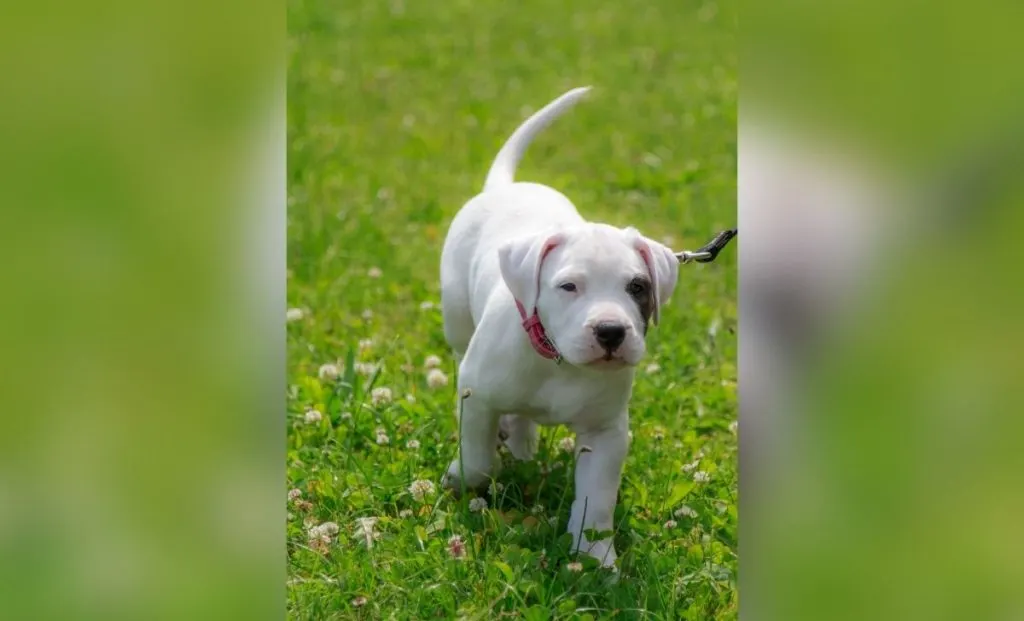
Understanding the stages a dog goes through gives a pet owner good grounds for adequate care and support of his growth process.
Knowledge about the stages enables an owner to plan for good nutrition, exercise, and training, which helps the dog grow healthy and well-adjusted.
It also promotes early recognition of health problems and timely veterinary intervention for the pet if needed.
More still, such information further enforces the bond between the pet and the owner in the realization of general welfare and happiness of the dog.
Birth to 4 Weeks: Neonatal and Early Socialization Periods
The eyes and ears of Dogo Argentino puppies, which are closed at birth and remain so, are without use within the first two weeks.
They solely depend on their mother for warmth and food at this age, just like any other breed. They spend three-quarters of the day sleeping or nursing; the other quarters develop their most basic senses.
In the third week of age, they open their eyes and ears to have their first vision and sense of sound.
They make their first attempts of standing and walking at this time. Puppy socialization commences at four weeks of age as they begin to play with their littermates.
5 To 8 Weeks: Socialization And Early Enrichment
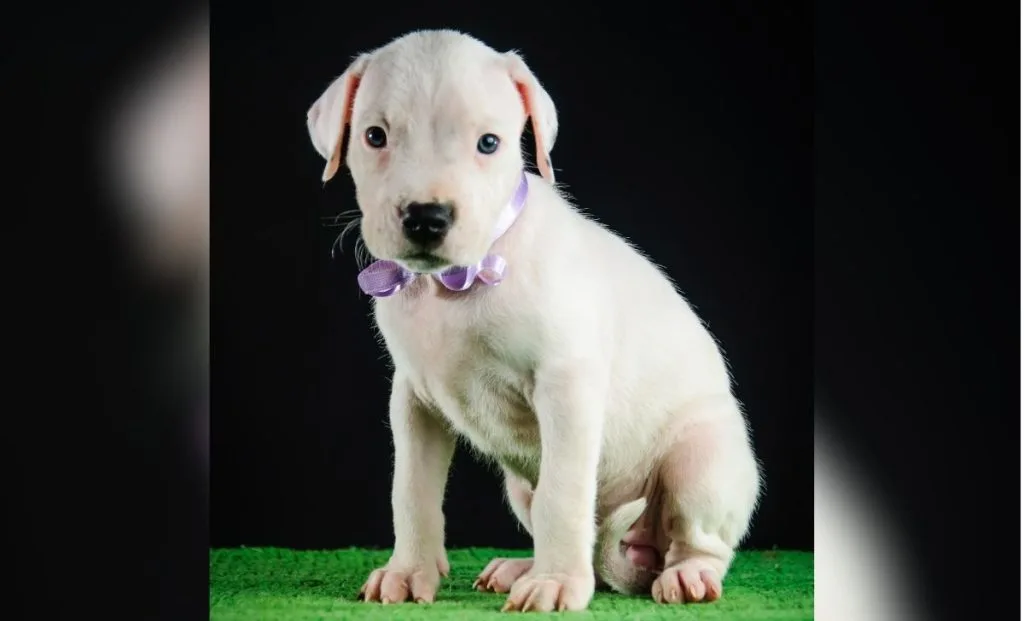
By this week, puppies are more stable and sporty around each other.
When the puppy is five weeks old, it’s the best time to introduce the first solid food, usually as a pate.
Your Dogo Argentino puppy becomes more social with its littermates and learns important behaviors through playing.
They are very curious from the sixth to eighth weeks, and distinct personality traits begin to show.
This is also an essential period for human contact to ensure that they grow into well-adjusted dogs.
2 To 4 Months: Juvenile Period
The Dogo Argentino puppy grows rapidly and develops from the second to the fourth month.
Puppy teeth are starting to come out, making some good chew toys useful. Basic obedience, potty, and socialization training should start using positive reinforcement techniques.
At the end of this stage, the puppies will be done with their first vaccinations and on the way to beginning exploration of the world exterior of the home.
4 To 6 Months: Early Adolescence
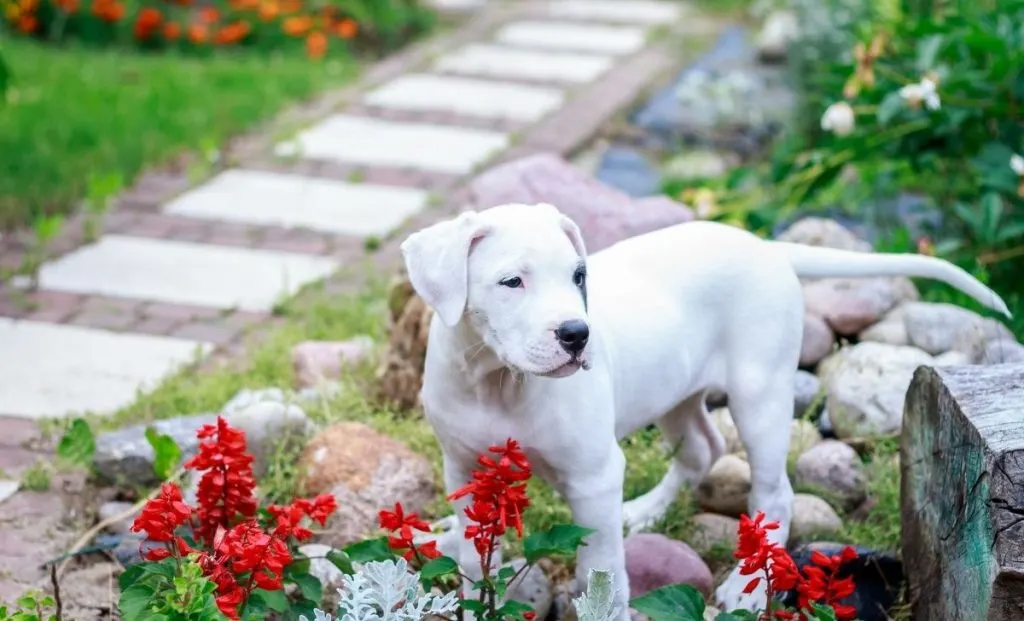
At this early adolescent stage, the puppies are still very much growing, and this is when your Dogo Argentino starts losing teeth and the adult teeth are starting to grow.
Puppies start to be characterized by an increased sense of independence and a need to escalate the testing of limits, so this period marks the beginning of stable and concrete training and continuous socialization.
In this period, the pup should have learned the basic commands and to walk on a leash. An increase in physical activities will tone its muscles and burn its energy.
6 To 9 Months: Adolescence
Dogo Argentinos enter a more pronounced adolescent phase at six to nine months.
The Dogo Argentinos reach half their adult size and weight; the adult coat starts developing.
Changes in behavior may be observed because the dog displays more independence and sometimes stubbornness. Continued training and good socialization are very important to consolidate good behavior.
This period may also encompass the first indications of sexual maturity, so it may be appropriate to discuss the question of whether my Dogo Argentino will be spayed with a veterinarian.
9 To 12 Months: Later Adolescence
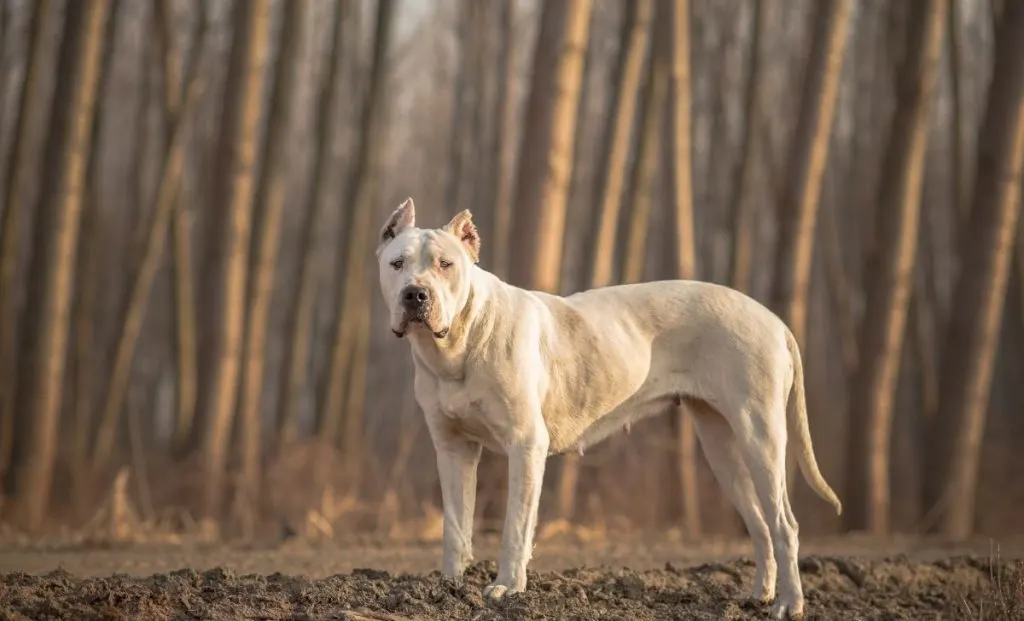
From nine to twelve months, your puppy will be almost at its full size and weight, but it might still fill out some and even develop more muscle.
By this age, the behavior will be more settled, but they still require a ton of exercise and mental stimulation. Training should be consistent and ongoing as they grow up and mature into well-behaved adults.
When a Dogo Argentino is a year old, it is usually well on its way to being a strong, assured animal, well-acclimated, and ready to face life with you.
You should take them to the vet for routine check-ups as part of their growing up while they are still small puppies. Remember, each puppy is different, so these small, individualistic differences in growth and behavior are normal.
Enjoy the journey with your Dogo Argentino because these early stages set the base for a lifetime of companionship.
Dogo Argentino Puppy Growth Spurts
Dogo Argentino puppies have several well-defined growth spurts within their life span, generally characterized by high rises in size and weight.
These represent the transitional periods when the small, dependent puppy changes into an adult who is strong and rather active. The first well-marked growth spurt usually extends for four to six weeks of age.
During this time, Dogo Argentino puppies expand their bodies with great speed, reflecting the need for high-quality nutrition to maintain this increased growth.
Weight needs to be watched closely, and they must be fed well since this period will serve as the future foundation. Another major growth spurt occurs in the four- to five-month border.
Usually, puppies of this age often look gangly, with their limbs growing faster than their bodies can fill out. This stage is characterized by increased height and weight, which occurs dramatically.
Adequate protein and other nutritional matters are essential for fully developing bones and muscles. At this time, regular veterinary checks are usually beneficial to check growth and deal with any problems that may arise.
Yet another major growth phase is encountered by Dogo Argentino puppies at approximately eight to nine months. This time is characterized by a tremendous increase not only in muscle bulk but in the size of the body as a whole.
Puppies start to fill out, and their physical capabilities increase significantly accordingly. This is a quick growth phase; proper nutrition and enough exercise are needed to prevent obesity and promote healthy development.
Normally, Dogos will be adults at 18 to 24 months when they mature from adolescence into young adults. This is where they have closed growth plates and are fully physically mature.
Though drastically slowed, growth can and does continue, particularly concerning building muscle mass and adding more weight. A proper diet and exercise will maintain these gains and improve overall health.
How Much Should I Feed My Dogo Argentino Puppy
The puppy from 8 to 12 weeks needs about four feedings a day. From 3 to 6 months, feeding should be cut back to three times a day.
Feed them twice a day after six months and up to a year, which should be sufficient. Feeding them with good-quality puppy food specially formulated for large breeds is necessary.
The volume of food in cups should be adjusted for puppy age and actual weight. At 8–12 weeks, provide 2–3 cups of food daily in four rations.
From 3 to 6 months, this should increase to about 3 to 4 cups of food daily in three meals. Between 6 and 12 months of age, the puppy may need about 4 to 6 mugs of dog food per day, divided into two meals.
Keep an eye on the puppy’s weight change and adjust the volume of the food portion.
Reduce the portion if a puppy shows signs of gaining too much weight. Add more food if you see the puppy looking just a bit thin. Do consult your vet for better advice based on your puppy’s needs.
Ensure that there is always fresh water, and do not overfeed to avoid problems of overindulgence and obesity.
Genetic Influence On Puppy Development
Both growth and health are so largely genetically dependent in the development of a Dogo Argentino.
Genetic factors will determine physical traits in your dog, such as size, coat color, and general proportion.
Dogo Argentinos are supposed to be strong dogs with many muscles and, therefore, a particular appearance. Their physical characteristics are passed through generations from strong, muscular ancestors.
Some health predispositions depend on genetic factors as well. Among conditions that tend to be hereditary for Dogo Argentinos are hip dysplasia, deafness, and skin allergies.
Detection and awareness of such problems usually lead to early diagnosis and management. Most quality breeders typically have their dogs tested for such conditions to avoid the probability of them being inherited by the puppies.
The behavioral area is another factor that is genetically determined.
While genetics do lay the groundwork, all the environmental factors, such as nutrition, training, and veterinary care, play an equal role in shaping your puppy’s growth and overall well-being.
All The Factors Influencing Dogo Argentino Growth
Several rudimentary factors will impact the development of your Dogo Argentino into a healthy and well-rounded adult. These include genetics, nutrition, exercise, healthcare, and environmental influences.
Genetics have already been mentioned as the first and most fundamental cause of predicting the potential size and build of your Dogo Argentino; inherited features will determine how large your dog will grow and even bone health and formation.
In turn, nutrition is crucial for proper growth. A proportional diet of proteins, fats, vitamins, and minerals supports your puppy during rapid growth and overall health.
Consequently, poor nutrition levels will cause defects in the growth and development of the puppy, stunting of growth, and increasing susceptibility to illnesses.
Strenuous exercises and physical activity help muscles develop and coordinate, all the while attaining an appropriate body weight in the dog.
The puppies ought to have mild and controlled play to avoid overstraining them and avoid injuries, but constant activity is helpful in the development of strong bones and muscles.
Health care, which ranges from a veterinary check-up, vaccines, and preventive treatments, ensures your puppy will grow without any health problems, and the early detection and prevention of potential health problems will lead to improved overall development and growth.
The environmental factors in which it is being raised, such as living conditions and the socialization place, also have their role in the influence of growth.
A stable, stress-free environment with perfect socialization gives a good start for further mental-emotional development and indirectly influences the puppy’s growth.
Proper socialization with other dogs and people should help Dogo Argentino develop the right behavioral traits to decrease anxiety and stress.
To Sum It All Up
These larger dogs might look scary to the average person, but they are good family dogs loyal to a fault.
Observing the growth and development of a Dogo Argentino puppy is very exciting and rewarding.
It is helpful to know the different factors that influence growth, like nutrition, proper health care, genetics, and exercise, to ensure you bring up your pup to his full potential.
Striking the right balance between caring and paying attention, your Dogo Argentino will develop into a healthy, strong, and well-adjusted companion ready to share many joyful moments.
Good luck, and enjoy every stage of his growth because you know that your efforts are laying the foundation so that, in due time, he will turn into a happy and thriving mature dog.
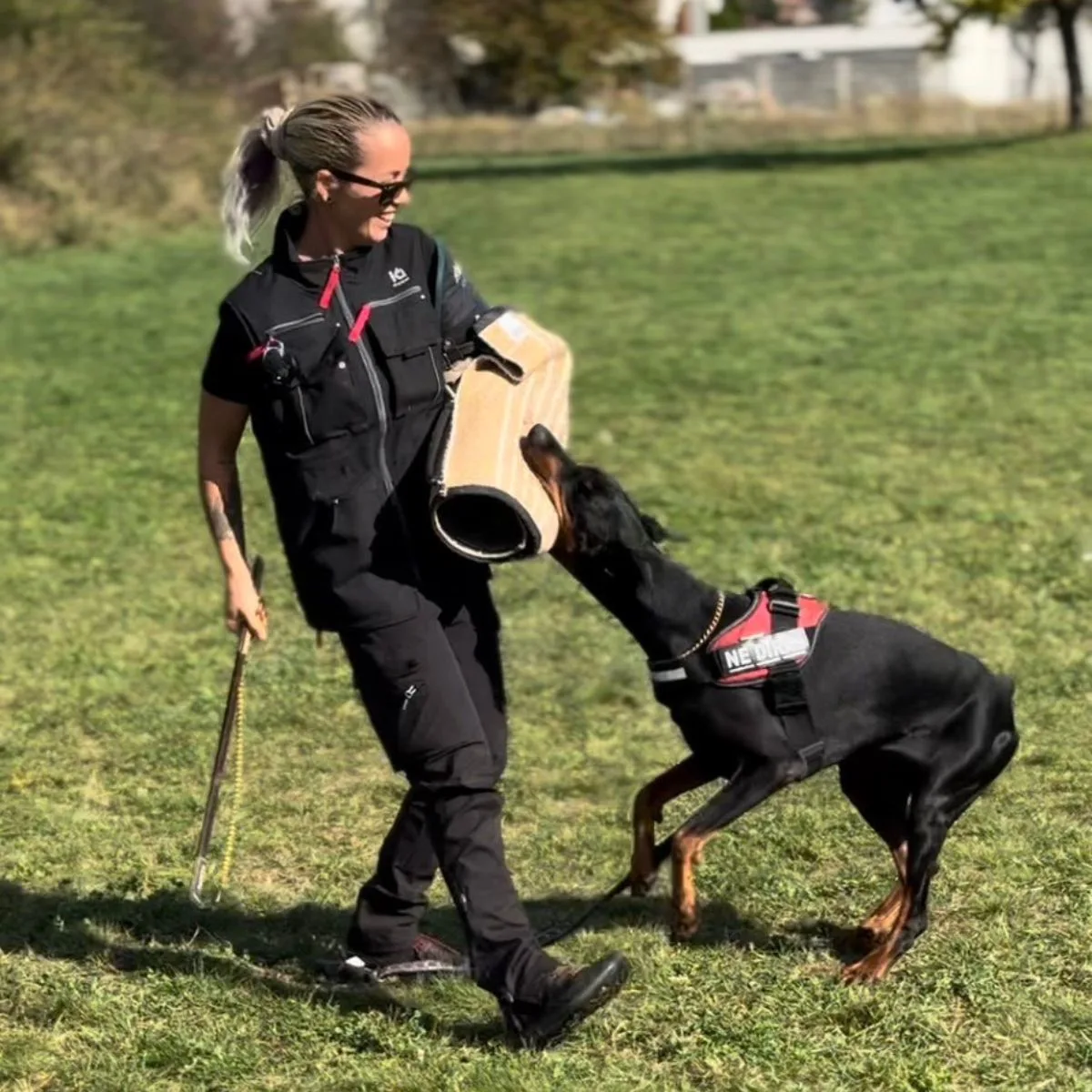
Nandina has been a lifelong dog owner and enthusiast. She shared her home with multiple breeds, including Giant Schnauzers, Cane Corsos, and Huskies. Currently, she is raising a three-year-old rescue and a working-line German Shepherd puppy.
Actively engaged in IGP dog sports for two years, Nandina is a certified instructor for basic obedience and socialization. She works as a trainer in her local dog sports club, and in her spare time, she handicrafts biothane gear for dogs.
